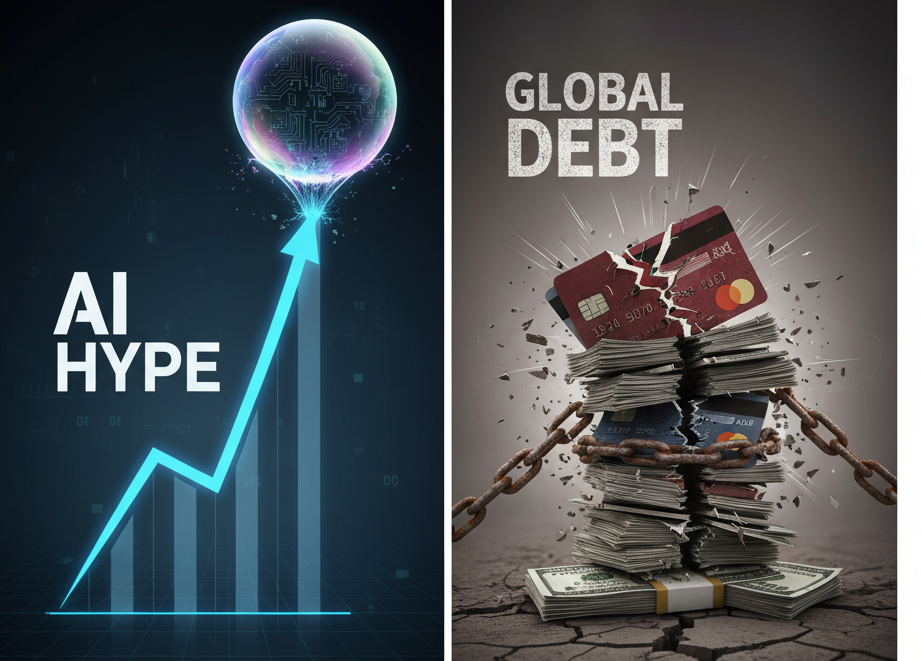The global financial system is exhibiting striking parallels with historical market manias, notably the period preceding the 1929 crash. For business leaders and owners, the core risk is a multi-crisis environment where multiple, reinforcing vulnerabilities could trigger an unprecedented financial and economic contraction.
1. The Overheated AI Hype Cycle
The market is being propelled by feverish speculation and massive investment in Artificial Intelligence (AI), with valuations stretched to historic highs (e.g., the Shiller P/E Ratio approaching dot-com and 1929 levels).

- The Bubble: Hopes for General Artificial Intelligence (AGI) have driven billions in investment. However, there are significant warnings that market expectations for productivity gains are grossly overestimated, with some reports suggesting AI has damaged output in fervently applied areas.
- Concentration Risk: A handful of tech “hyperscalers” (Meta, Alphabet Inc., Microsoft , Amazon, etc.) are driving nearly half of US GDP growth through massive AI infrastructure investment. The global economy’s fortunes are becoming precariously dependent on the judgment and success of this small cluster of companies.
- The Inevitable Bust: While tech titans argue that this is a “good bubble” that will leave behind a fantastic infrastructure (“an era of abundance”), all booms end in a bust. Over-investment will lead to a glut of spare capacity, massive financial losses, a credit squeeze, and subsequent investment drought.
2. The Debt Time Bomb and Fading Confidence
Overlaying the stock market fragility is a monstrous global debt crisis.

Bond Market Strike: Investors are increasingly reluctant to finance mountainous government debts, causing interest rates to rocket and raising the cost of refinancing for virtually everyone.- Private Credit Meltdown: The less-regulated Private Credit sector, which grew by lending to higher-risk enterprises, is facing a severe crisis as the underlying risks are exposed, leading to monumental losses.
- Loss of Trust in Fiat: The soaring price of gold and growing interest in alternatives like Bitcoin signals a broad loss of trust in the US Dollar and the global fiat currency system. Unaffordable US stimulus and growing national debt (over 100% of GDP in most advanced economies) fuel this concern.
3. Limited Defenses Against the Next Crash
Crucially, when the next major crisis hits, global policymakers are severely limited in their ability to respond effectively compared to 2008.

- Exhausted Ammunition: Both the fiscal and monetary ‘canon’ are largely exhausted. National debts are too high for massive new fiscal stimulus (borrowing), and central banks are hesitant to repeat the money printing (Quantitative Easing) of the past, given its role in stoking asset bubbles and wealth inequality.
- Absence of Cooperation: Unlike the concerted global effort during the 2008 financial crisis, the current environment is defined by competing ideologies, geopolitical instability (remilitarisation, potential major conflicts), and a lack of international resolve, making a united global bailout unlikely.
Action Point for Leaders
While it’s impossible to predict the trigger or the timing—”as long as the music is playing, you’ve got to get up and dance”— we as business leaders and owners must recognise that the stars are aligned for a significant financial reckoning.
The biggest risk today is the confluence of negatives: an overvalued AI market, a global debt crisis, and extreme geopolitical instability, all while policy options are constrained. This makes the eventual transition from one economic age to the next an almost guaranteed financial, political, and social catastrophe.
How is your business preparing for a world with diminished central bank firepower and a potential systemic shock in the tech and credit markets?
